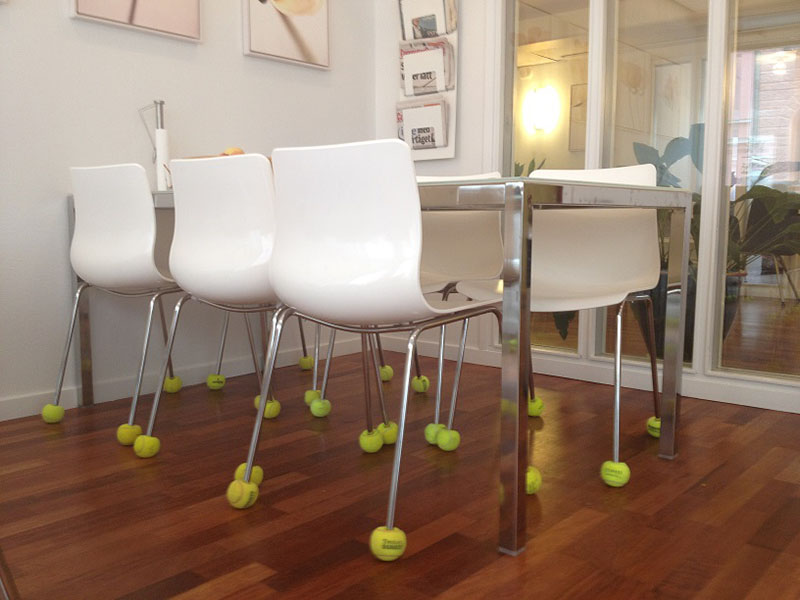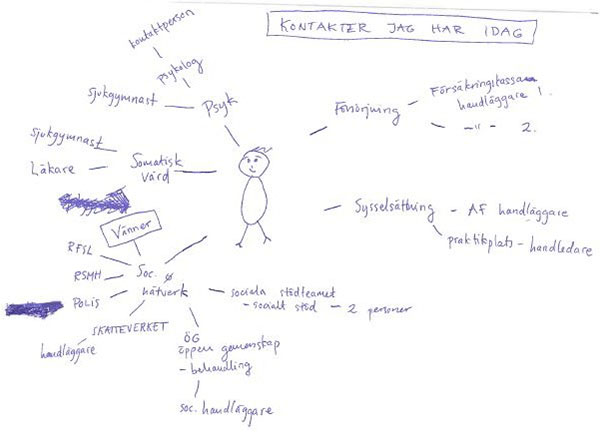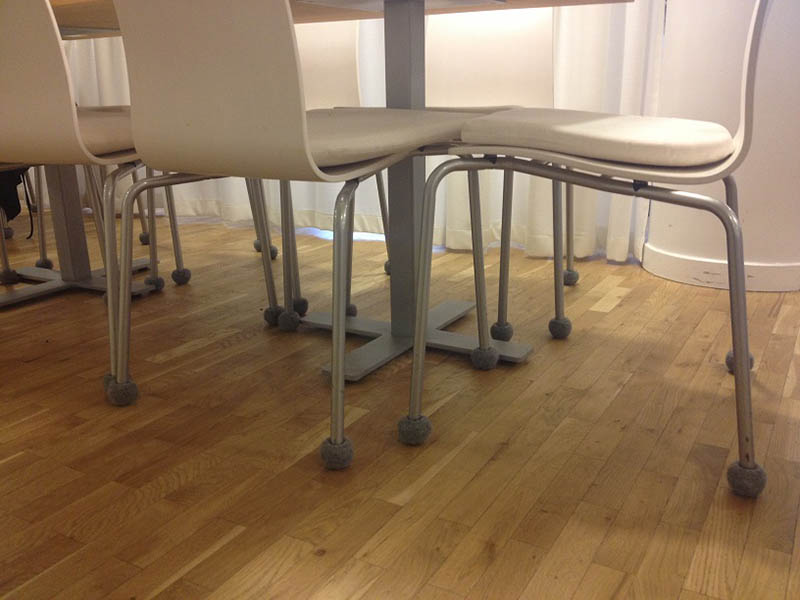At my office we put tennis balls on the legs of the chairs to reduce the noise of the scraping chairs against the parquet floors. They are hard to miss, but they fulfill their purpose. For this reason, I never reflected on what kind of feelings these bright fluorescent yellow balls might evoke when visitors see them attached to the bottom of the meeting room’s chair legs.

Photo: © Begripsam, 2018
How can tennis balls make such a difference?
That was, until one day when I was a part of a project start-up meeting together with a group of people who have the lived experience of mental health problems. One participant commented that it was funny how she enjoyed coming to our meetings once in a week but hated many of the other meetings she was supposed to take part in. Another person commented that he, too, was reluctant to come to the first meeting at our office, but now felt fine attending. Then a third person said, “For me, I decided to take part in the project as soon as I saw those tennis balls on the legs of the chairs”. To my surprise, all 8 participants in the meeting nodded and murmured in agreement. It turned out that everyone had noticed this one small thing and appreciated the way they reduced the noise made by chairs rasping against the floor. This relates to the fact that many people with mental health problems are sensitive to sharp unpleasant noises, such as the sound of chairs being dragged back from the table, screeching on the wooden floor.
What does it mean to be marginalized in Sweden?
Being a mental health survivor, at least in Sweden, means being subject to many actors and many activities all aimed to include you in society. Potentially there are 30-50 actors that could engage in a homeless person’s process of re-establishment to society. Since all want to meet the homeless person often on weekly or monthly basis some participants will have 100-200 meetings in a year. This picture is often unclear for the homeless person. I use a method of drawing contact maps to visualize the number of actors involved and then the number of meetings. In addition to the homeless person, other participants present can include social welfare agents, housing assistant representatives, mental health counsellors, social benefits advisors, etc. Often the homeless person takes on the blame for missing meetings but looking at the contact map defers blame and allows reflection on why the support is organized as it is, and whether it is effective or not. By visualizing and discussing, we can start to question basic practices such as why society sends postal invitations to homeless people, whether all those meetings are meaningful, and if the number of meetings could be reduced by using smart technology.

Photo: © Begripsam, 2018
Trustmarkers
It was during a contact map exercise, that our discussion for the first time touched what I later called ‘trustmarkers’. Realizing that meetings are core to people who live with mental health problems and that a willingness to attend these meetings is an important first step, I re-examined the tennis balls and asked myself what they really signified.
Together with a group of participants who experience mental health problems, we started to dig deeper into why the tennis balls made a difference. How could they be so important to the process of a person deciding to take part in a research project about technology? The answer emerged early on in the discussion and it turned out that all of the participants were very observant of small cues in the interior design of the meeting place (at least this was the case at the office where I work). It turned out that a majority of the group had not definitely decided to take part when they entered the first meeting. The decision was made during the first meeting and the tennis balls – the trust markers – had been important in that process. From the perspective of those with mental health issues, the tennis balls represented and signalled “kindness”, “thoughtfulness” and “respect”. As one person said, “If someone had made the effort to go to the tennis court, pick up old and used tennis balls, punch a hole in them and place them on chairs legs just to get a quiet environment – that person must be a good person”. My organization gained the participants’ trust and our project gained trust. And even though it was not me who had put the tennis balls on the chair legs, I too gained the participants’ trust.

Photo: © Begripsam, 2018
After the initial tennis ball discovery, our office replaced the tennis balls with more aesthetically pleasing, less obvious, grey balls. Surprisingly, these similar, expensive, and “designed” grey plugs did not work as trustmarkers. They functioned as they should and reduced the noise but they failed to act as a statement relating to trust. They were designed to be invisible and the design worked. No one noticed them anymore. The trust effect returned as soon as we switched back to the yellow balls.
Trustmarkets in physical spaces
Tennis balls were not the only trustmarkers that influenced the way those with mental health issues experienced meetings. Later we discovered other trustmarkers when it comes to the interior design of meeting spaces. Plants, for instance, could be both trust markers and threats — it depended on the shape of the leaves. Round leaves = trust. Sharp, pointed leaves elicited negative feelings. Lighting was also important. Shadows on the walls from lighting held different significance: rounded shadows (especially from the ceiling and down towards the floor) = feelings such as coziness, comfort, trust. Shadows with sharp edges (especially pointing upwards) = threats, uncomfortable feelings. As designers and researchers working within design contexts that include marginalized people, it is critical to recognize the complexity of such trustmarkers, yet it is important to understand the significance of these markers. A fluorescent yellow tennis ball might just be the perfect solution. I found this out — all thanks to my colleague Tommy who got fed up with the scraping noise from the chairs in our kitchen and bought some cheap, used tennis balls from the local tennis club and solved the problem.
Trustmarkers in digital spaces
Trust markers in physical spaces can also translate into the ways in which technology is designed. Taking this concept, my colleagues and I developed a structured event where those with mental health problems, social workers and designers meet and hold what we call ‘a design session’. During these sessions we have found that the design of computer interfaces also contains trust markers. The key common factor here is to take into consideration the small things that affect others with mental health problems and then take steps to consider and accommodate them in the design of spaces – in computing and in the real world. A common trustmarker in a digital space is an easy to find reference to a telephone number. They may not intend to use it, but being able to find it signals that the owner can be contacted and therefore builds trust. An icon letting you know that text can be read out loud by text-to-speech technology is yet another small (digital) thing. While few people actually use it, its presence build trust. A well-known trustmarker is the logotype on a web page. Other subtler trustmarkers seems to be related to features that are not present. If the design, for example, avoids clutter, avoids content that automatically moves or flicker it gains trust – indicating that trustmarkers also can be something not present.
Further reading
Johansson, Stefan, Jan Gulliksen, and Ann Lantz. “User Participation When Users have Mental and Cognitive Disabilities.” Proceedings of the 17th International ACM SIGACCESS Conference on Computers & Accessibility. ACM, 2015. URL: https://dl.acm.org/citation.cfm?id=2809849
S. Johansson, “Towards a framework to understand mental and cognitive accessibility in a digital context,” Licentiate Thesis. KTH Royal Institute of Technology, 2016. URL: http://urn.kb.se/resolve?urn=urn:nbn:se:kth:diva-183168

2 Trackbacks